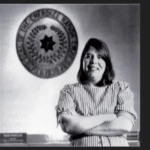Quote:
Western movies always seemed to show Indian women washing clothes at the creek and men with a tomahawk or spear in their hands, adorned with lots of feathers. That image has stayed in some people’s minds. Many think we’re either visionaries, “noble savages”, squaw drudges or tragic alcoholics. We’re very rarely depicted as real people who have greater tenacity in terms of trying to hang on to our culture and values system than most people.
Source:
Jone Johnson Lewis (2017): Wilma Mankiller Quotes. (Orgina source unknown).
Author Bio:
Wilma Mankiller (1945-2010) was a Native American activist, feminist and chief of the Cherokee/Tsalagi Nation.
Context:
 Stereotypical depictions of Native Americans are widespread, especially in Western films, but also in other genres. They were often presented in one-sided terms as a violent threat, which retrospectively justified the dispossession and genocides of indigenous peoples in the Americas by the Hollywood culture industry. At the same time, white people were mostly portrayed as individuals and representatives of a higher culture, thereby strengthening white supremacy. Wilma Mankiller, the first female chief of the Cherokee, worked with empowerment techniques and the dissemination of positive self-images from marginalised groups in order to counteract this specific racist image production. John Wayne, the best-known Western actor, said of the dispossession of indigenous peoples: ‘We did nothing wrong in taking this great land from them. This so-called theft was nothing but a matter of survival’ (Der Spiegel, 06/11/2019).
Stereotypical depictions of Native Americans are widespread, especially in Western films, but also in other genres. They were often presented in one-sided terms as a violent threat, which retrospectively justified the dispossession and genocides of indigenous peoples in the Americas by the Hollywood culture industry. At the same time, white people were mostly portrayed as individuals and representatives of a higher culture, thereby strengthening white supremacy. Wilma Mankiller, the first female chief of the Cherokee, worked with empowerment techniques and the dissemination of positive self-images from marginalised groups in order to counteract this specific racist image production. John Wayne, the best-known Western actor, said of the dispossession of indigenous peoples: ‘We did nothing wrong in taking this great land from them. This so-called theft was nothing but a matter of survival’ (Der Spiegel, 06/11/2019).Further Reading:
*Neil Diamond (2010): Reel Injun. Dokumentary. (Trailer)
*Red Haircrow et al. (work in progress): Forget Winnetou. Going beyond Native Stereotypes. Dokumentary.
*Matika Wilbur (2013): Changing the way we see Native Americans. Dokumentary.
*Der Spiegel (11.06.2019): Wild ist der Westen, schwer ist der Beruf.
Year:
2000